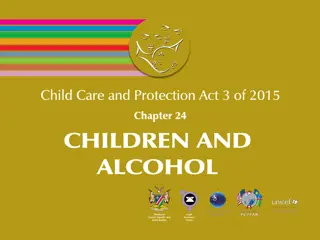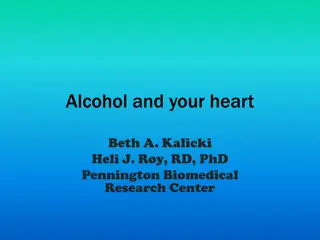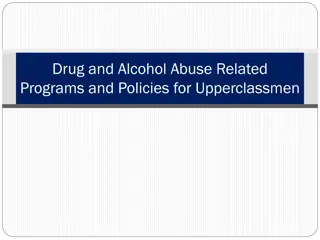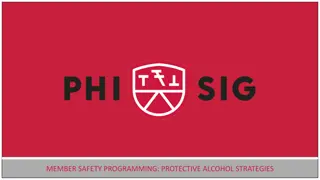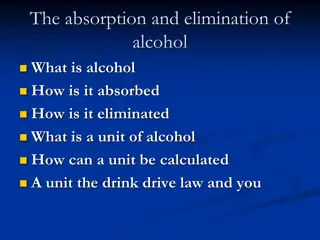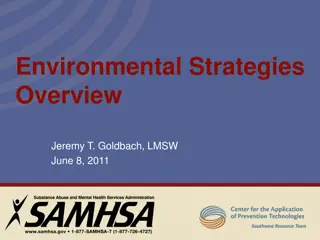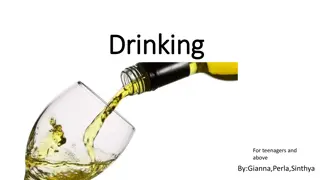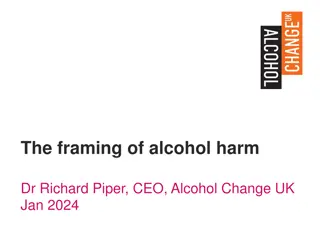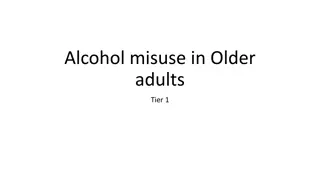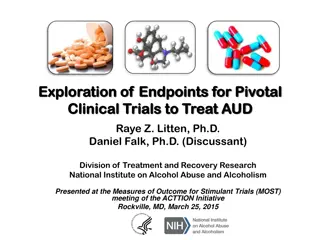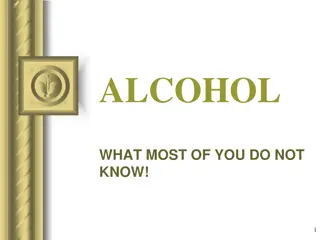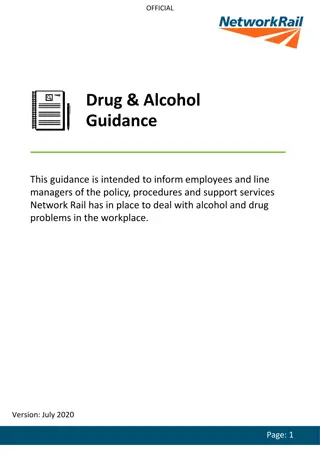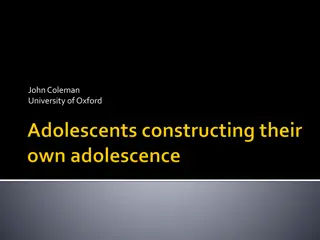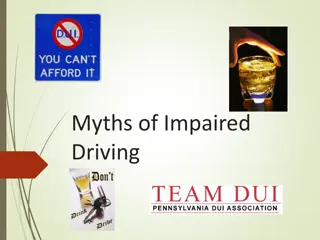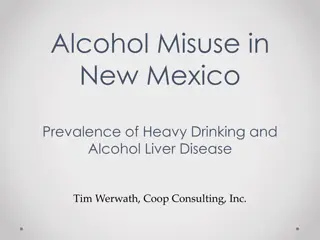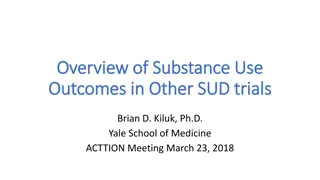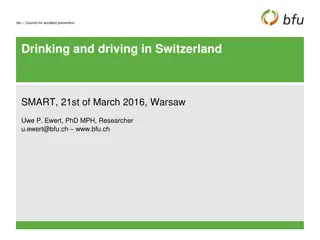Understanding Effective Alcohol Policy and Adolescent Drinking
Exploring the complexities and impacts of alcohol consumption among adolescents, this module delves into the mechanisms behind alcohol-related harms and strategies to mitigate risks. From pricing policies to educational interventions, a comprehensive approach is essential for addressing alcohol harm effectively.
Uploaded on Sep 30, 2024 | 0 Views
Download Presentation

Please find below an Image/Link to download the presentation.
The content on the website is provided AS IS for your information and personal use only. It may not be sold, licensed, or shared on other websites without obtaining consent from the author. Download presentation by click this link. If you encounter any issues during the download, it is possible that the publisher has removed the file from their server.
E N D
Presentation Transcript
Alcohol Policy and Adolescent Drinking: Using Science in the Public Interest Module 2 Introduction to effective alcohol policy Alcohol Policy and Adolescent Drinking
Alcohol control what works? The evidence base Alcohol Policy and Adolescent Drinking
Alcohol: No ordinary commodity The benefits connected with the production, sale, and use of this commodity come at an enormous cost to society. Three important mechanisms explain alcohol s ability to cause medical, psychological, and social harm: 1. physical toxicity 2. Intoxication 3. dependence Public health responses must be matched to this complex vision of the dangers of alcohol as they seek better ways to respond to population-level harms. Alcohol Policy and Adolescent Drinking 3
Strategies and interventions to reduce alcohol-related harm upstream and downstream Upstream Regulating the physical availability Pricing and taxation Regulating alcohol promotion Drinking-driving countermeasures Modifying the drinking context Treatment and early intervention services Downstream Education and persuasion strategies Alcohol Policy and Adolescent Drinking
There is no silver bullet A comprehensive framework of policies is needed to effectively tackle alcohol harm Alcohol Policy and Adolescent Drinking
1. Price Theoretical assumption: Increasing the economic cost of alcohol relative to alternative commodities will reduce demand Pricing policies include: Increased taxes Minimum pricing Bans on below cost sales and happy hour drink discounts Low alcohol tax incentives/special taxes on certain products, e.g., alcopops Alcohol Policy and Adolescent Drinking 6
Evidence to support pricing policies Pricing policies based on sound economic theory when the price of a product goes up, demand decreases Studies from around the world show that increased taxation on alcohol results in reduced rates of consumption, alcohol-related deaths, crime, violent assaults, traffic accidents. Minimum pricing in Canada has reduced alcohol harm: In British Colombia, 10% ave price increase = 9% reduction in alcohol related crime, 9% reduction in hospitalisations Young people and heavy drinkers are particularly price sensitive Taxes on alcopops reduces consumption amongst young people Lower taxes on low alcohol products leads to product switching Alcohol Policy and Adolescent Drinking 7
2. Restrictions on availability Theoretical assumption: Reducing supply by restricting physical availability will increase effort to obtain alcohol, and thereby reduce total volume consumed as well as alcohol- related problems. Policies to control availability include: Limitations on hours and days of sale Limitations on number, location and density of places of sale Minimum purchase age restrictions Public drinking bans Alcohol Policy and Adolescent Drinking 8
Limitations on days and hours of sale International evidence shows increased hours and days of sale = increased alcohol consumption and associated harms: Australia Brazil Canada Nordic countries USA UK: introduction of 24-hr alcohol availability under Licensing Act 2003: Increased levels of crime and anti-social behaviour between 3am-6am Increased police expenditure and resource allocation during early hours St Thomas A&E Department, London sharp increase in overnight alcohol-related admissions Alcohol Policy and Adolescent Drinking 9
Closing time: Effects on homicides in Diadema, Brazil (1995-2005) Alcohol Policy and Adolescent Drinking 10
Limiting number of retail outlets Number and density of outlets associated with increased levels of alcohol-related violence and crime Density of outlets impacts young people bringing together large numbers of potential victims and aggressors Number/density of outlets not always an indicator of availability if large supermarket is licensed, alcohol may become more available even though number of small licensed shops may fall Alcohol Policy and Adolescent Drinking 11
Limiting number of retail outlets: State monopolies State Monopolies seen as effective policy: Limit outlet numbers and density, regulate hours and days of sale, no profit incentive to offer price promotions Countries that have dismantled state monopolies have had sharp rise in alcohol harm Finland, 1969 relaxed state monopoly regulations to allow beer up to 4.7% to be sold in grocery stores: After one year, overall alcohol consumption increased 46% After five years, liver cirrhosis mortality increased 50%; hospital admissions for alcohol psychoses increased 110% in men, 130% in women After five years, arrests for drunkenness increased 80% men, 160% women But, state monopolies politically unfeasible in many countries? Alcohol Policy and Adolescent Drinking 12
Minimum Legal Purchase Age (MLPA) USA 1984 National Minimum Purchase Age Act: encouraged states to adopt the age 21 purchase standard The number of young people who died in a crash when an intoxicated young driver was involved declined by almost 63% Studies from US show increasing purchase age = decrease numbers alcohol-related road traffic accidents and fatalities (19% net decrease amongst young drivers) Some evidence to suggest reduced rates of suicide and vandalism Enforcement is key to success compliance checks and mystery shopper tests UK: Tackling Underage Sales of Alcohol Campaign (TUSAC) repeated test purchasing across 3k licensed premises 2007. 40% failed first test, 8% failed 2nd test Alcohol Policy and Adolescent Drinking 13
Public drinking bans Dramatic declines in arrests, assaults and ejections from a University football stadium following a ban on alcohol sales 86% of Canadian communities that adopted formal policies experienced reductions in problems such as underage drinking, fighting, and vandalism London Transport ban on drinking 2008 assaults on tube staff fell 15% International evidence suggests alcohol-free zones may impact on young people, who tend to drink in parks and other public places USA bans on alcohol in sports stadiums = reductions in arrests, ejections and assaults Alcohol Policy and Adolescent Drinking 14
3. Modifying the drinking context Theoretical assumption: Creating environmental and social constraints will limit alcohol consumption and reduce alcohol related violence. Emergence of youth oriented vertical drinking establishments = increase in binge-drinking, alcohol related violence and social disorder Factors that impact on levels of alcohol related violence include: Overcrowding Poor bar layout/inconvenient bar access Permissive environment Bar workers failing to practice responsible serving Irresponsible promotions e.g., happy hour Use of toughened glass has reduced glassing attacks & facial injuries Bar staff training effective if penalties are enforced High profile policing in and around licensed areas reduced crime & social disorder: TASC project, Cardiff, increased police enforcement at known problem venues = 4% decrease alcohol-related assaults after 12 months Alcohol Policy and Adolescent Drinking 15
4. Drink-driving Theoretical assumption: Deterrence, punishment, and social pressure will reduce drink-driving. Risk of crash increases with increased Blood Alcohol Content (BAC) Drivers with a BAC of between 0.02 and 0.05 have at least a three times greater risk of dying in a vehicle crash. This risk increases to at least six times with a BAC between 0.05 and 0.08 Most countries have per se laws concerning specific BAC levels at which a driver is presumed to be impaired and can be arrested A BAC of 0.05% (0. 5 mg/ml) is the standard in many countries Policies that lower BAC limits consistently reduce drink-driving Alcohol Policy and Adolescent Drinking 16
Drink-driving enforcement and penalties Without enforcement the effects diminish over time Random breath tests Highly visible, non-selective testing can have a sustained effect in reducing drinking- driving and the associated crashes, injuries, and deaths Penalties need to be severe enough to act as a deterrent license revocation/fines/imprisonment Zero tolerance laws for young and novice drivers have been proven to reduce youth casualties and fatalities Alcohol Policy and Adolescent Drinking 17
5. Education strategies Theoretical assumption: Health information that increases knowledge and changes attitudes will prevent drinking problems. School-based alcohol education programs are among the most popular types of prevention programs for policymakers. Approaches include: mass media campaigns alcohol warning labels school-based alcohol education Alcohol Policy and Adolescent Drinking 18
Mass media campaigns: Public service announcements (PSAs) Messages prepared by Governments, NGOs, health agencies, and media organizations that deal with responsible drinking, the hazards of drinking-driving, and related topics Despite their good intentions, PSAs are an ineffective antidote to the high-quality pro- drinking messages that appear much more frequently as paid advertisements in the mass media Alcohol Policy and Adolescent Drinking 19
Warning labels Emphasis has been placed on the potential for birth defects when alcohol is consumed during pregnancy, and the danger of alcohol impairment when driving Some evidence that warning labels impact knowledge, awareness, intentions and perceptions No convincing evidence of an effect on alcohol consumption and driving after drinking Alcohol Policy and Adolescent Drinking 20
School-based alcohol education programs Can increase knowledge and change attitudes toward alcohol, but do not change drinking behavior Modest changes in drinking have been associated with programs that include both resistance skills training and normative education Alcohol Policy and Adolescent Drinking 21
Summary: Information education communication Education strategies in the absence of changes in the environment have shown little or no effect, regardless of the approach taken or the level of investment Many countries include information about alcohol in health curriculum/ lifestyle education They can increase knowledge but won t change behavior Among the hundreds of studies, only a few show lasting effects (after 3 years) Even comprehensive programs may not be sufficient to delay initiation of drinking or sustain small reductions after program ends Programs with multiple interactive components that resemble family therapy and brief intervention seem to have some potential Many programs shown to be ineffective continue to be used Alcohol Policy and Adolescent Drinking 22
6. Regulating alcohol promotion Theoretical assumption: Reducing exposure to marketing, which normalizes drinking and links it with social aspirations, will slow recruitment of drinkers and reduce heavier drinking by young persons. The marketing of alcohol is a global industry Alcohol brands are advertised through television, radio, print, point-of-sale promotions, and the Internet Strong evidence that exposure to alcohol marketing: Reduces age at which drinking starts Increases the amounts drunk by young people Alcohol Policy and Adolescent Drinking 23
Policy options for alcohol marketing No regulation Industry self-regulation Co-regulation Partial bans Total bans Alcohol Policy and Adolescent Drinking 24
Regulation of marketing the current landscape Reliance on voluntary marketing codes set by industry Typically address content, not volume of marketing Codes often state that alcohol marketing: Must not be aimed at young people or depict young people in ads Must not link alcohol consumption to social/sexual success, enhanced physical performance or driving Must not make therapeutic claims Must not encourage immoderate consumption or present abstinence in a negative light Must not portray intoxication and risky behavior Note promotion by price often not included Studies in Canada, the UK, Australia, Brazil, USA, the European Union and Ireland show that self-regulation codes are systematically violated by beer and spirits producers in terms of youth exposure, objectionable content, and complaint processing Alcohol Policy and Adolescent Drinking 25
Examples of alcohol marketing code violations Images sourced from Google Images Alcohol Policy and Adolescent Drinking
Industry self-regulation codes Self-regulation tends to be fragile and largely ineffective These codes may work best where the media, advertising, and alcohol industries are all involved, and an independent body has powers to approve or veto advertisements, rule on complaints, and impose sanctions Few countries currently have all these components Alcohol Policy and Adolescent Drinking 27
Controls to reduce exposure Exposure restrictions limit advertising to certain hours of the day, and forbid alcohol ads on programs likely to be watched by children Despite these voluntary guidelines, children and adolescents are exposed to large amounts of alcohol marketing in countries without total bans Alcohol Policy and Adolescent Drinking 28
Model policy: Loi Evin Passed in 1985 but not defined and enforced until 1991 Definition of alcoholic drinks (1.2% or more alcohol by volume) No advertising targeted at young people No ads on TV or in movies No sponsorship of cultural or sporting events Advertising permitted only in the press for adults, on billboards, on radio Messages and images should refer only to the qualities of the product such as origin, composition, production, etc. A health message must be included on each ad Alcohol Policy and Adolescent Drinking 29
Conclusions and policy implications A marked increase in alcohol marketing, especially in emerging markets Unprecedented levels of exposure of young persons to sophisticated marketing Voluntary codes of content have been shown to be ineffective in a variety of countries Unlike tobacco, there is, as yet, no international or regional agreement to restrict alcohol marketing Alcohol Policy and Adolescent Drinking 30
7. Treatment and early intervention services Theoretical assumption: Alcohol dependence will be prevented by motivating heavy drinkers to drink moderately; various therapeutic interventions will increase abstinence among persons who have developed a dependence on alcohol. Interventions for non-dependent high-risk drinkers consist of one to three sessions of counseling or advice delivered in general medical settings Interventions for alcohol dependence consist of individual and group therapy to maintain abstinence and mutual help societies to support long-term recovery Alcohol Policy and Adolescent Drinking 31
Effectiveness of brief intervention and treatment services Randomized control trials show that interventions and brief advice reduce alcohol problems amongst non- dependent high risk drinkers In general, exposure to any treatment is associated with significant reductions in alcohol use and related problems, regardless of the type of intervention used. Access to services and resource allocation are important for success of any kind of treatment and brief intervention Alcohol Policy and Adolescent Drinking 32
Conclusions Alcohol problems can be minimized or prevented using a coordinated, systematic policy response. Alcohol policies that limit access to alcoholic beverages, discourage driving under the influence of alcohol, reduce the legal purchasing age for alcoholic beverages, limit marketing exposure and increase the price of alcohol, are likely to reduce the harm linked to drinking In most countries, taxation offers the most cost-effective strategy, but there are exceptions owing to illicit production The known effective interventions produce a favorable health return for cost incurred in policy implementation Alcohol Policy and Adolescent Drinking 33


